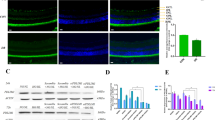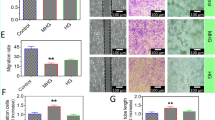Abstract
Advanced proliferative diabetic retinopathy (PDR) characterized by aberrant retinal angiogenesis is a leading cause of retinal detachment and blindness. Krüppel-like factor 9 (KLF9), a member of the zinc-finger family of transcription factors, participates in the development of diabetic nephropathy and the promotion of angiogenesis of human umbilical vein endothelial cells. Therefore, we speculate that KLF9 may exert a crucial role in PDR. The current study revealed that KLF9 was highly expressed in the high glucose (HG)-treated human retinal microvascular endothelial cells (HRMECs) and the retinas of oxygen-induced retinopathy (OIR) rats. Knockdown of KLF9 inhibited the proliferation, migratory capability, invasiveness and tube formation of HG-treated HRMECs. Besides, knockdown of KLF9 decreased the expression of yes-associated protein 1 (YAP1) in HG-treated HRMECs. Dual-luciferase reporter assays confirmed that KLF9 transcriptionally upregulated YAP1 expression. Overexpression of YAP1 reversed the KLF9 silencing-induced repression of HRMEC proliferation and tube formation. Further in vivo evidence demonstrated that knockdown of KLF9 reduced the expression of Ki67, CD31 and vascular endothelial growth factor A (VEGFA) in the retinas of OIR rats. Collectively, KLF9 silencing might mitigate the progression of PDR by inhibiting angiogenesis via blocking YAP1 transcription.






Similar content being viewed by others
Data Availability
The data that support the findings of this study are available from the corresponding author upon reasonable request.
References
Cho, N. H., Shaw, J. E., Karuranga, S., Huang, Y., da Rocha Fernandes, J. D., Ohlrogge, A. W., & Malanda, B. (2018). IDF diabetes atlas: Global estimates of diabetes prevalence for 2017 and projections for 2045. Diabetes Research and Clinical Practice, 138, 271–281.
Stitt, A. W., Curtis, T. M., Chen, M., Medina, R. J., McKay, G. J., Jenkins, A., Gardiner, T. A., Lyons, T. J., Hammes, H. P., Simo, R., & Lois, N. (2016). The progress in understanding and treatment of diabetic retinopathy. Progress in Retinal and Eye Research, 51, 156–186.
Gucciardo, E., Loukovaara, S., Salven, P., & Lehti, K. (2018). Lymphatic vascular structures: a new aspect in proliferative diabetic retinopathy. Int J Mol Sci., 19, 4034.
Ruiz, M. A., Feng, B., & Chakrabarti, S. (2015). Polycomb repressive complex 2 regulates MiR-200b in retinal endothelial cells: Potential relevance in diabetic retinopathy. PLoS ONE, 10, e0123987.
Potente, M., Gerhardt, H., & Carmeliet, P. (2011). Basic and therapeutic aspects of angiogenesis. Cell, 146, 873–887.
Xu, Y., Lu, X., Hu, Y., Yang, B., Tsui, C. K., Yu, S., Lu, L., & Liang, X. (2018). Melatonin attenuated retinal neovascularization and neuroglial dysfunction by inhibition of HIF-1alpha-VEGF pathway in oxygen-induced retinopathy mice. Journal of Pineal Research, 64, e12473.
Bagati, A., Moparthy, S., Fink, E. E., Bianchi-Smiraglia, A., Yun, D. H., Kolesnikova, M., Udartseva, O. O., Wolff, D. W., Roll, M. V., Lipchick, B. C., Han, Z., Kozlova, N. I., Jowdy, P., Berman, A. E., Box, N. F., Rodriguez, C., Bshara, W., Kandel, E. S., Soengas, M. S., … Nikiforov, M. A. (2019). KLF9-dependent ROS regulate melanoma progression in stage-specific manner. Oncogene, 38, 3585–3597.
Tetreault, M. P., Yang, Y., & Katz, J. P. (2013). Kruppel-like factors in cancer. Nature Reviews Cancer, 13, 701–713.
He, X., & Zeng, X. (2020). LncRNA SNHG16 aggravates high glucose-induced podocytes injury in diabetic nephropathy through targeting miR-106a and thereby up-regulating KLF9. Diabetes, Metabolism, Syndrome and Obesity: Targets and Therapy, 13, 3551–3560.
Cui, A., Fan, H., Zhang, Y., Zhang, Y., Niu, D., Liu, S., Liu, Q., Ma, W., Shen, Z., Shen, L., Liu, Y., Zhang, H., Xue, Y., Cui, Y., Wang, Q., Xiao, X., Fang, F., Yang, J., Cui, Q., & Chang, Y. (2019). Dexamethasone-induced Kruppel-like factor 9 expression promotes hepatic gluconeogenesis and hyperglycemia. The Journal of Clinical Investigation, 129, 2266–2278.
Li, H., Weng, Y., Lai, L., Lei, H., Xu, S., Zhang, Y., & Li, L. (2021). KLF9 regulates PRDX6 expression in hyperglycemia-aggravated bupivacaine neurotoxicity. Molecular and Cellular Biochemistry, 476, 2125–2134.
Ma, L., Li, Z., Li, W., Ai, J., & Chen, X. (2019). MicroRNA-142-3p suppresses endometriosis by regulating KLF9-mediated autophagy in vitro and in vivo. RNA Biology, 16, 1733–1748.
Piccolo, S., Dupont, S., & Cordenonsi, M. (2014). The biology of YAP/TAZ: Hippo signaling and beyond. Physiological Reviews, 94, 1287–1312.
Wen, D., Wang, L., Tan, S., Tang, R., Xie, W., Liu, S., Tang, C., & He, Y. (2020). HOXD9 aggravates the development of cervical cancer by transcriptionally activating HMCN1. Panminerva Medica. https://doi.org/10.23736/S0031-0808.20.03911-7
Chen, J., Wang, X., He, Q., Bulus, N., Fogo, A. B., Zhang, M. Z., & Harris, R. C. (2020). YAP activation in renal proximal tubule cells drives diabetic renal interstitial fibrogenesis. Diabetes, 69, 2446–2457.
Liu, J., Xu, L., & Zhan, X. (2020). LncRNA MALAT1 regulates diabetic cardiac fibroblasts through the Hippo-YAP signaling pathway. Biochemistry and Cell Biology, 98, 537–547.
Pan, Q., Gao, Z., Zhu, C., Peng, Z., Song, M., & Li, L. (2020). Overexpression of histone deacetylase SIRT1 exerts an antiangiogenic role in diabetic retinopathy via miR-20a elevation and YAP/HIF1alpha/VEGFA depletion. American Journal of Physiology: Endocrinology and Metabolism, 319, E932–E943.
Han, N., Tian, W., Yu, N., & Yu, L. (2020). YAP1 is required for the angiogenesis in retinal microvascular endothelial cells via the inhibition of MALAT1-mediated miR-200b-3p in high glucose-induced diabetic retinopathy. Journal of Cellular Physiology, 235, 1309–1320.
Wang, Z., Xing, W., Song, Y., Li, H., Liu, Y., Wang, Y., Li, C., Wang, Y., Wu, Y., & Han, J. (2018). Folic acid has a protective effect on retinal vascular endothelial cells against high glucose. Molecules., 23, 2326.
Lam, J. D., Oh, D. J., Wong, L. L., Amarnani, D., Park-Windhol, C., Sanchez, A. V., Cardona-Velez, J., McGuone, D., Stemmer-Rachamimov, A. O., Eliott, D., Bielenberg, D. R., van Zyl, T., Shen, L., Gai, X., D’Amore, P. A., Kim, L. A., & Arboleda-Velasquez, J. F. (2017). Identification of RUNX1 as a mediator of aberrant retinal angiogenesis. Diabetes, 66, 1950–1956.
Connor, K. M., Krah, N. M., Dennison, R. J., Aderman, C. M., Chen, J., Guerin, K. I., Sapieha, P., Stahl, A., Willett, K. L., & Smith, L. E. (2009). Quantification of oxygen-induced retinopathy in the mouse: A model of vessel loss, vessel regrowth and pathological angiogenesis. Nature Protocols, 4, 1565–1573.
Fernando, K. H. N., Yang, H. W., Jiang, Y., Jeon, Y. J., & Ryu, B. (2018). Diphlorethohydroxycarmalol isolated from Ishige okamurae represses high glucose-induced angiogenesis in vitro and in vivo. Mar Drugs., 16, 375.
Li, R., Du, J., Yao, Y., Yao, G., & Wang, X. (2019). Adiponectin inhibits high glucose-induced angiogenesis via inhibiting autophagy in RF/6A cells. Journal of Cellular Physiology, 234, 20566–20576.
Wang, Y., Wang, L., Guo, H., Peng, Y., Nie, D., Mo, J., & Ye, L. (2020). Knockdown of MALAT1 attenuates high-glucose-induced angiogenesis and inflammation via endoplasmic reticulum stress in human retinal vascular endothelial cells. Biomedicine & Pharmacotherapy, 124, 109699.
Fallah, A., Sadeghinia, A., Kahroba, H., Samadi, A., Heidari, H. R., Bradaran, B., Zeinali, S., & Molavi, O. (2019). Therapeutic targeting of angiogenesis molecular pathways in angiogenesis-dependent diseases. Biomedicine & Pharmacotherapy, 110, 775–785.
Hartnett, M. E. (2015). Pathophysiology and mechanisms of severe retinopathy of prematurity. Ophthalmology, 122, 200–210.
Abdullah, S. E., & Perez-Soler, R. (2012). Mechanisms of resistance to vascular endothelial growth factor blockade. Cancer, 118, 3455–3467.
Lee, J. W., Ko, J., Ju, C., & Eltzschig, H. K. (2019). Hypoxia signaling in human diseases and therapeutic targets. Experimental & Molecular Medicine, 51, 1–13.
Han, N., Xu, H., Yu, N., Wu, Y., & Yu, L. (2020). MiR-203a-3p inhibits retinal angiogenesis and alleviates proliferative diabetic retinopathy in oxygen-induced retinopathy (OIR) rat model via targeting VEGFA and HIF-1alpha. Clinical and Experimental Pharmacology and Physiology, 47, 85–94.
Zhang, W. Y., Wang, J., & Li, A. Z. (2020). A study of the effects of SGLT-2 inhibitors on diabetic cardiomyopathy through miR-30d/KLF9/VEGFA pathway. European Review for Medical and Pharmacological Sciences, 24, 6346–6359.
Millimaggi, D., Mari, M., D’Ascenzo, S., Carosa, E., Jannini, E. A., Zucker, S., Carta, G., Pavan, A., & Dolo, V. (2007). Tumor vesicle-associated CD147 modulates the angiogenic capability of endothelial cells. Neoplasia, 9, 349–357.
Abu El-Asrar, A. M., Ahmad, A., Alam, K., Siddiquei, M. M., Mohammad, G., Hertogh, G., Mousa, A., & Opdenakker, G. (2017). Extracellular matrix metalloproteinase inducer (EMMPRIN) is a potential biomarker of angiogenesis in proliferative diabetic retinopathy. Acta Ophthalmologica, 95, 697–704.
Noda, K., Ishida, S., Inoue, M., Obata, K., Oguchi, Y., Okada, Y., & Ikeda, E. (2003). Production and activation of matrix metalloproteinase-2 in proliferative diabetic retinopathy. Investigative Ophthalmology & Visual Science, 44, 2163–2170.
Zhong, Z., Zhou, F., Wang, D., Wu, M., Zhou, W., Zou, Y., Li, J., Wu, L., & Yin, X. (2018). Expression of KLF9 in pancreatic cancer and its effects on the invasion, migration, apoptosis, cell cycle distribution, and proliferation of pancreatic cancer cell lines. Oncology Reports, 40, 3852–3860.
Zhu, M., Liu, X., Wang, Y., Chen, L., Wang, L., Qin, X., Xu, J., Li, L., Tu, Y., Zhou, T., Sang, A., & Song, E. (2018). YAP via interacting with STAT3 regulates VEGF-induced angiogenesis in human retinal microvascular endothelial cells. Experimental Cell Research, 373, 155–163.
Yan, Z., Shi, H., Zhu, R., Li, L., Qin, B., Kang, L., Chen, H., & Guan, H. (2018). Inhibition of YAP ameliorates choroidal neovascularization via inhibiting endothelial cell proliferation. Molecular Vision, 24, 83–93.
Potilinski, M. C., Lorenc, V., Perisset, S., & Gallo, J. E. (2020). Mechanisms behind retinal ganglion cell loss in diabetes and therapeutic approach. International Journal of Molecular Sciences, 21, 2351.
Amato, R., Lazzara, F., Chou, T. H., Romano, G. L., Cammalleri, M., Dal Monte, M., Casini, G., & Porciatti, V. (2021). Diabetes exacerbates the intraocular pressure-independent retinal ganglion cells degeneration in the DBA/2J model of glaucoma. Investigative Ophthalmology & Visual Science, 62, 9.
Apara, A., Galvao, J., Wang, Y., Blackmore, M., Trillo, A., Iwao, K., Brown, D. P., Jr., Fernandes, K. A., Huang, A., Nguyen, T., Ashouri, M., Zhang, X., Shaw, P. X., Kunzevitzky, N. J., Moore, D. L., Libby, R. T., & Goldberg, J. L. (2017). KLF9 and JNK3 interact to suppress axon regeneration in the adult CNS. Journal of Neuroscience, 37, 9632–9644.
Galvao, J., Iwao, K., Apara, A., Wang, Y., Ashouri, M., Shah, T. N., Blackmore, M., Kunzevitzky, N. J., Moore, D. L., & Goldberg, J. L. (2018). The Kruppel-like factor gene target dusp14 regulates axon growth and regeneration. Investigative Ophthalmology & Visual Science, 59, 2736–2747.
Xie, J., Gong, Q., Liu, X., Liu, Z., Tian, R., Cheng, Y., & Su, G. (2017). Transcription factor SP1 mediates hyperglycemia-induced upregulation of roundabout4 in retinal microvascular endothelial cells. Gene, 616, 31–40.
Cao, X., Xue, L. D., Di, Y., Li, T., Tian, Y. J., & Song, Y. (2021). MSC-derived exosomal lncRNA SNHG7 suppresses endothelial-mesenchymal transition and tube formation in diabetic retinopathy via miR-34a-5p/XBP1 axis. Life Sciences, 272, 119232.
Wilkinson-Berka, J. L., Tan, G., Jaworski, K., Harbig, J., & Miller, A. G. (2009). Identification of a retinal aldosterone system and the protective effects of mineralocorticoid receptor antagonism on retinal vascular pathology. Circulation Research, 104, 124–133.
Deliyanti, D., Zhang, Y., Khong, F., Berka, D. R., Stapleton, D. I., Kelly, D. J., & Wilkinson-Berka, J. L. (2015). FT011, a novel cardiorenal protective drug, reduces inflammation, gliosis and vascular injury in rats with diabetic retinopathy. PLoS ONE, 10, e0134392.
Acknowledgements
Not applicable.
Author information
Authors and Affiliations
Corresponding author
Ethics declarations
Conflict of Interest
The authors declare that they have no conflict of interest.
Additional information
Publisher's Note
Springer Nature remains neutral with regard to jurisdictional claims in published maps and institutional affiliations.
Rights and permissions
Springer Nature or its licensor holds exclusive rights to this article under a publishing agreement with the author(s) or other rightsholder(s); author self-archiving of the accepted manuscript version of this article is solely governed by the terms of such publishing agreement and applicable law.
About this article
Cite this article
Han, N., Zhang, L., Guo, M. et al. Knockdown of Krüppel-Like Factor 9 Inhibits Aberrant Retinal Angiogenesis and Mitigates Proliferative Diabetic Retinopathy. Mol Biotechnol 65, 612–623 (2023). https://doi.org/10.1007/s12033-022-00559-0
Received:
Accepted:
Published:
Issue Date:
DOI: https://doi.org/10.1007/s12033-022-00559-0




